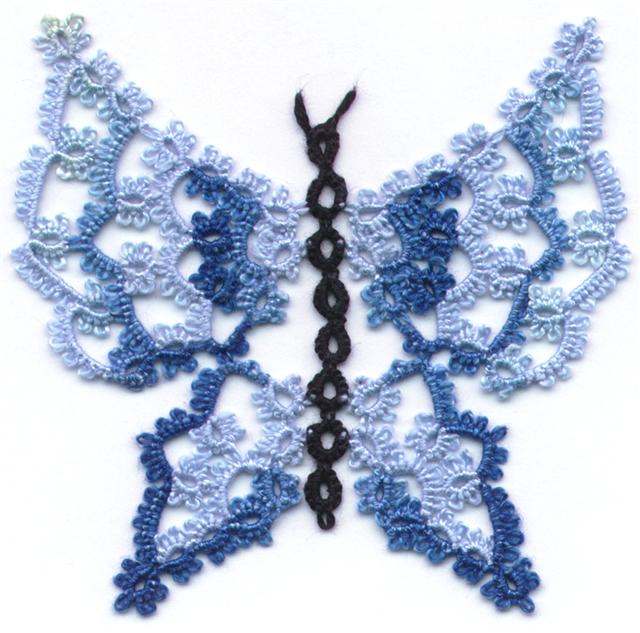
Many years ago I tatted an edging from Janet Carroll's book Elegant Tatting patterns and attached to to a hanky. I used sewing thread put out by Mettler that was quite fine and it seemed to me to tat up much finer that size 80, so I'm guessing that it would be around size 100. The design is almost all rings.
Put a fine thread together with a pattern that has a lot of rings and you get a disaster looking for a place to happen. The thread broke. About every 6 inches or so, it broke. Usually it broke at the base of the ring I had just completed leaving me with a core thread about a quarter of an inch long. I learned many creative ways of hiding old ends and new ends.
One of the things that I learned is that when you have 2 old threads and 2 new threads to hide,
sometimes it is better to unwind enough thread from the shuttle so that it can be used as a "ball" thread (wound CTM) so that you only have the 2 old threads to hide at the break and you can work a little bit further using the tail of the shuttle thread so that when it runs out you can introduce a new thread and hide the 2 new threads at another location.
I was being "clever" when I started this hanky and I started at the corner and designed the corner "on the fly" when I got to the second corner I decided that I didn't like my first corner treatment. I figured no problem, I'd just change the design to something I liked better and fix the first corner when I got to the end. So I made a change to the corner design and kept on working around the hanky tatting the edging directly on to the hanky as I went, breaking threads every few inches.
Then I got to the last corner and on the last pattern repeat of the 4th side, the thread broke. No matter how I worked it I was going to have 6 ends to hide. 2 old ends, 2 new ends plus matching it up to the starting end which I had cleverly decided that I would CUT off and replace the first corner treatment which adds 2 starting ends. That was six ends to hide inside one cloverleaf, in addition to making joins not into picots, but into the teeny little bump of thread on the opposite side of the join.
Those of you who have done this kind of repair know what I am talking about, but for those of you new to tatting. Think of how you make a join. You pull a loop of thread through the picot and put the shuttle through the loop. Then you pull the loop back down. Now imagine that the picot is cut. All that is left on the other side is the strand of thread that went through the loop. So now imagine that you are working with really fine thread. That means that there isn't enough room to get a hook under that loop, there is barely enough room for a strand of thread.
When I cut off the starting corner I worked it so that I had the minimal amount of crazy backward joins to do. I cut the starting corner and hid the old thread finger tatting toward the corner. Then I undid part of the last pattern repeat on the fourth side added in new thread and hid 2 of the ends. I worked the first ring of the corner clover leaf and then the second ring. I managed to hide all of the ends even the itty bitty quarter inch ends, heaved a sigh of relief and closed the last ring. Whereupon the the thread broke.
See this pretty hanky? It's sewn onto the tatting board I use to show people what tatting is. Notice how you can't see the 4th corner? I know when to quit.


2 comments:
I thought this sharing was fascinating because up until a recent edging I had not had any breaking threads - so I couldn't "relate" when tatters spoke of thread breaking or cutting their fingers! Well, my dear, I've now joined that dubious club of broken threads - I found your saga to be very instructive and a good lesson in patience!
X BJ
Post a Comment